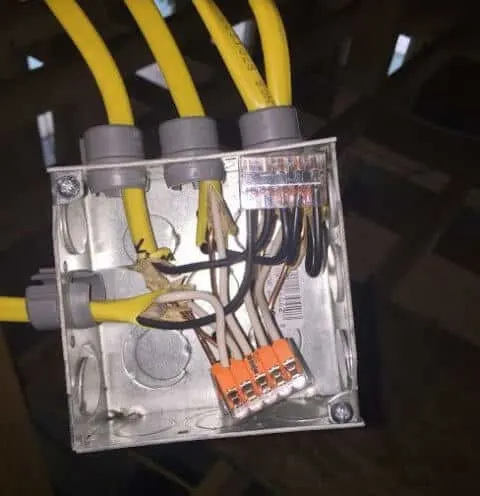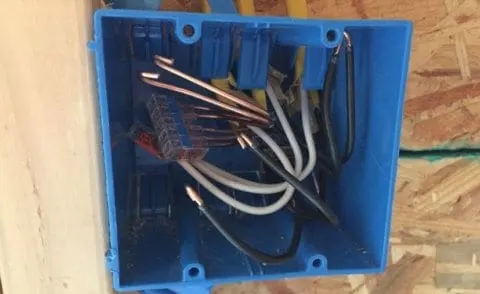In 2016 while planning the design of my family’s new home, I began to research Wago lever nuts, unique electrical wire connectors that offer distinct advantages over traditional wire nuts. I was fascinated by the concept and the potential ease of use that these wire connectors would offer. But were Wago wire connectors really superior to wire nuts?
In 2016, I decided to put them to the test in the most realistic testing situation possible. I wired my entire house with Wago nuts.
I will walk you through all of my findings but here’s the bottom line.
Wago nuts vs. wire nuts – Wago nuts offer specific advantages in electrical wiring for the DIY homeowner. These include:
- Visual Confirmation of Electrical Connections
- Easy wire removal and replacement
- Can be used to connect solid and stranded wires
- Combine wire sizes with confidence
Let’s take a look at each of these specific advantages that the Wago lever nuts hold over traditional wire nuts. But first, a little clarification.
There is more than one model of Wago wire nuts. The 222 series has a solid colored plastic casing. The model I’m referencing here is the 221 series which features a clear plastic housing.
Visual Confirmation of Electrical Connections

One of the most unnerving aspects of wire nuts is not being able to see whether or not the wires inside have a solid connection to each other. This can result in shortages and even fire hazards.
One of the first features that sold me on Wago nuts vs. wires nuts was the ability to have visual confirmation of connections. Wago lever nuts have a clear housing that allows you to see the wire inside it. This gives you the ability to actually see the wire touching the inside connector.
Additionally, the levels press down on the wire once it’s inserted to prevent the wires from slipping out.
I cannot tell you how much confidence this instills when wiring up connections. Being able to see and “feel” that the connection is solid makes it much easier to put that project aside and move forward.
Easy Wire Removal And Replacement

From time to time, you may find yourself needing to add an additional wire to the group. Maybe you are adding a light or extending power to another room. While this can be very frustrating as you work to remove and then replace a large wire nut onto a set of wires, using the Wago nuts make this process simple and intuitive.
Simply lift the lever on an unused slot in the Wago nut and insert the new wire. Close the lever and you are done!
Removing or replacing a wire is just as simple. The key is that the wires are not all twisted together inside a wire nut. Each is laid out into its own dedicated slot. The wires sit side by side allowing quick and easy removal and replacement.
Connect Solid and Stranded Wires

Every DIY homeowner knows that you aren’t supposed to mix solid and stranded wire in a wire nut. Yet, many electrical devices such as ceiling fans come with stranded wire and a set of wire nuts.
What the heck?
Wago nuts solve the dilemma of connecting solid and stranded wire through its design. Since each wire is inserted into its own dedicated slot, connections between different wire types can be completed without issue.
I found using these to wire ceiling fans throughout my home to be the quickest way to complete connections with absolute certainty. As a bonus, they prevent finger cramps from all the twisting of wire nuts. 🙂
Combine Wire Sizes With Confidence
One of the most frustrating issues with traditional wire nuts comes into play when connecting wires of different gauge sizes. It can be challenging to find a wire nut that will accomodate a larger wire while still having the teeth to catch the smaller one.
Again, Wago lever nuts solve this issue. Accommodating wires from 24-12 AWG, I found it refreshingly non-frustrating to connect these different wire sizes.
About The Company
Wago is an international company founded in Minden, Germany in 1951. The company has wide offering of UL listed, electrical-related products including electrical connections and automation technology.
Wago performs a series of tests on all products including an extensive list of mechanical, electrical, material, and environmental. For a full list of testing checks, see their guidelines page on the company’s website.
This company video gives an overview of the Wago 221 series connectors.
Wago Nut Ratings and Specs
Wago 221 series lever nuts are rated at 450 volts and use copper connector material. They can be used in surrounding air temperatures of 185 degrees Fahrenheit and can handle a continuous operating temperature of 221 degrees Fahrenheit according to the Wago website.
Wago nuts are UL certified. The certifications are available for review on the company website.
Conclusion
After wiring my own home using Wago Lever Nuts, I’ve since assisted by brother-in-law in wiring his home where we also used these. In addition, we upgraded the wiring in a rental property with the Wago nuts.
We have never had an issue or regret. From my perspective, these are solid connectors and an excellent alternative to traditional wire nuts.
On the rare occasion that I need to open up a junction box or light switch box to add or replace wiring, the task is super-simple thanks to the lever control design.
For example, I wired my house as a smart home when I built it. From time to time I will upgrade a traditional light switch to a smart switch. Thanks to the Wago lever nuts, I have no issues with connecting the stranded ground wire that comes with many of these smart switches to the solid wire that is in my walls.
I would encourage you to visit the company’s website and do your own research. From my experience, there is little reason for the DIY homeowner to choose traditional plastic wire nuts over this newer approach to connecting electrical wires.
To see the assortment of Wago Lever Nuts available from Amazon, click here.
As a homeowner, I am constantly experimenting with making the structure of my house more energy-efficient, eliminating pests, and taking on DIY home improvement projects. Over the past two decades, my family has rehabbed houses and contracted new home builds and I’ve learned a lot along the way. I share my hard-learned lessons so that you can save time and money by not repeating my mistakes.


Leave a comment
You must be logged in to post a comment.